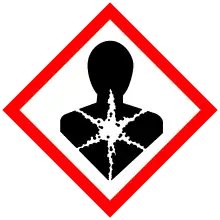Cadmium phosphide
Cadmium phosphide (Cd3P2) is an inorganic chemical compound. It is a grey or white bluish solid semiconductor material with a bandgap of 0.5 eV.[1] It has applications as a pesticide, material for laser diodes and for high-power-high-frequency electronics.[1]
| Names | |
|---|---|
| Other names
Tricadmium diphosphide | |
| Identifiers | |
3D model (JSmol) |
|
| ChemSpider | |
| ECHA InfoCard | 100.031.437 |
| EC Number |
|
PubChem CID |
|
CompTox Dashboard (EPA) |
|
| |
| |
| Properties | |
| Cd3P2 | |
| Molar mass | 399.178 g/mol |
| Appearance | bluish white[1] or gray[2] |
| Density | 5.96 g/cm3[1] |
| Melting point | 700[1] °C (1,292 °F; 973 K) |
| Electron mobility | 1500 cm2/Vs[1] |
Refractive index (nD) |
3.88[1] |
| Structure | |
| Tetragonal | |
| Hazards | |
| GHS pictograms |    |
| GHS Signal word | Warning |
| H302, H312, H314, H318, H332, H350, H370, H400, H410 | |
| P201, P202, P210, P233, P261, P264, P270, P271, P273, P280, P301+312, P302+352, P304+340, P308+313, P312, P330, P362+364, P391, P405, P501 | |
Except where otherwise noted, data are given for materials in their standard state (at 25 °C [77 °F], 100 kPa). | |
| Infobox references | |
Synthesis and reactions
Cadmium phosphide can be prepared by the reaction of cadmium with phosphorus:
- 3 Cd + 2 P → Cd3P2
Structure
Cd3P2 has a room-temperature tetragonal form.
The crystalline structure of cadmium phosphide is very similar to that of zinc phosphide (Zn3P2), cadmium arsenide (Cd3As2) and zinc arsenide (Zn3As2). These compounds of the Zn-Cd-P-As quaternary system exhibit full continuous solid-solution.[3]
Safety
Like other metal phosphides, it is acutely toxic when swallowed due to the formation of phosphine gas when it reacts with gastric acid. It is also carcinogen and dangerous for the skin, eyes and other organs in a large part due to cadmium poisoning.
References
- "Cadmium Phosphide (Cd3P2) Semiconductors". azom.com. 2013-08-19. Retrieved 2020-10-25.
- "Cadmium Phosphide Cd3P2". americanelements.com. Retrieved 2020-10-25.
- Trukhan, V. M.; Izotov, A. D.; Shoukavaya, T. V. (2014). "Compounds and solid solutions of the Zn-Cd-P-As system in semiconductor electronics". Inorganic Materials. 50 (9): 868–873. doi:10.1134/S0020168514090143. S2CID 94409384.